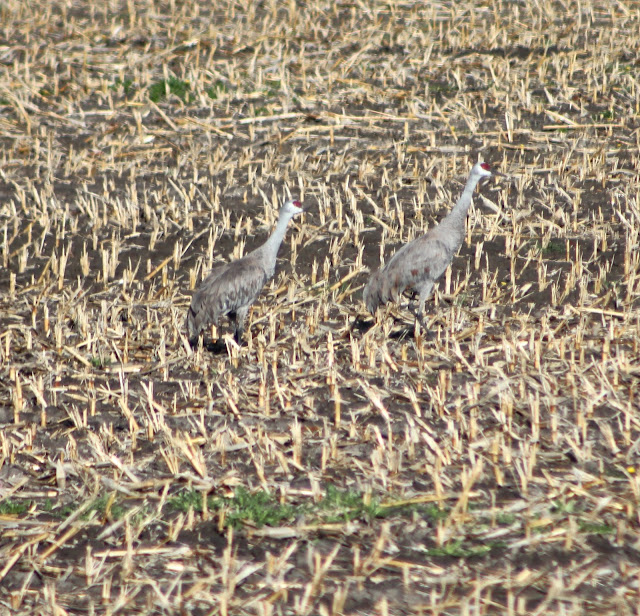Nebraska really does look like it does in the movies.. We saw groves of Cottonwoods along the Platte River - the kind to which cowboys tide their horses.
Omigosh! I think those are cranes!
They are! Those are Sandhill cranes!
They are very well camouflaged Lesser sandhill cranes (Grus canadensis canadensis)
When I left home for our speedy drive across America from West Virginia to Reno Nevada, I hoped to see a Sandhill crane. On our last trip, (in the fall, one and a half years ago) I saw two Sandhill cranes beside a ranch pond near Genoa, Nevada. I didn't realize what I had seen until we were well past the cranes.
I hadn't known it, but Jeff knew that the Platte River in Nebraska was a major stop in the Sandhill crane's spring migration flight.
Once he told me that, I was really hoping to see one. My eyes were peeled.
This trip was one with almost no stops. We stopped to gas-up the truck about every two hundred miles and for meals but not for anything else. Once we came close to the Platte, I said, "I really would like to stop if we happen to see a Sandhill crane."
Ten minutes later I saw what you see in these photographs.
All photographs were taken from our car going about 70 miles per hour.
It is estimated that about 500,000 Sandhill cranes stop along the Platte River in Nebraska.
We saw several thousand.
They tended to be in fields which had been full of corn last summer. They spend their days in these fields getting the calories needed to complete their trip and to find mates. Their nights are spent roosting on the sand hills above the Platte. (ed. As you can see from the comment below from Julie Zickefoose, they actually roost "in" the river. Julie actually knows these things.)
In the fields the cranes search out kernels of corn left behind by the pickers.
Sandhill cranes have flown from Southern United States and must be hungry.
This area is a major stop on their way to the northern United States and southern Canada.
They mate for life and stay with their mate year 'round.
When migrating they migrate along with their offspring.
Their wingspan is about 5.3 feet for females to about 7 feet for males. They weigh 7.4 to 11 pounds respectably. They are beautiful. (I learned that on my own.)
One of the internet bird identifications said that seeing the Sandhill cranes along the Platte River is a once-in-a-lifetime event. I agree. My jaws hurt from Smiling. Thank-you to circumstantial fate.
-------------------------------------------------------------





















5 comments:
Nelle, I so wish you could have built in a day to stay a night in Kearney and go to the Rowe Sanctuary before dawn. There, they have blinds you can enter in the dark. As the light comes up you hear the cranes murmuring and calling. These migrating birds don't nest in the sandhills--they nest in the northern Plains states (three pairs in NW Ohio! but most in MN and WI and on north all over Canada). What they do in March along the Platte is roost all night right in the river, which is the only place they're safe from coyotes. They lift off sometime after dawn, and you're in a blind only a few feet away. It is absolutely breathtaking and well worth stopping and staying to experience it. I spent my childhood birding from a car doing 75-80 and can empathize...sometimes you really do need to stop and stare at the cranes!
Oops! I really did mean "roost" not "nest". I have now edited the post fixing that. Also a note about being "in" the river. I really wish we could have stopped. If we had been in our camper van we would have. I will definitely plan that for another trip.
nellie
that's awesome! so cool to see!
What a lovely bird to get to see. I have went over for migration and it is worth the stop just to listen to them. I have worked a lot in the Sandhills, a little farther north along the Niobrara.
What luck! I'm glad you got to stop. Like Julie, we stayed a few days and took in the early am trips to the blinds. When they stir, get ready to take off and then fly, it is amazing!
Great pictures, too! Thanks for sharing,
Cindy
Post a Comment